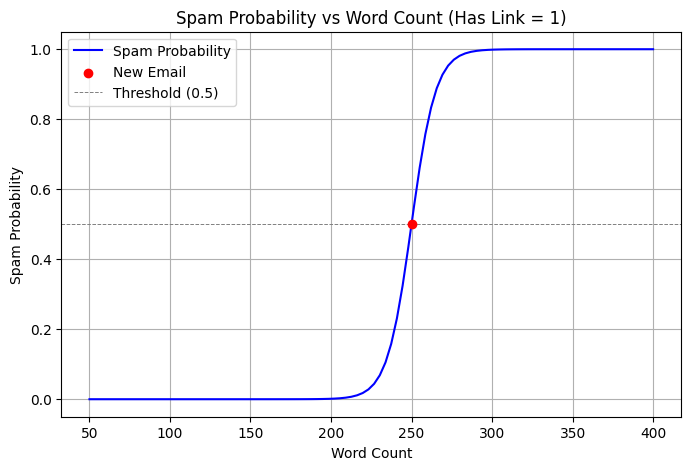Logistic Regression
Logistic Regression is a statistical method used for binary classification problems. It predicts the probability that an observation belongs to one of two classes. Instead of fitting a straight line (as in linear regression), logistic regression uses the logit function (sigmoid curve) to model probabilities.
Logistic Regression Equation
The logistic regression model estimates the probability (p) of the dependent variable (Y) being 1, based on one or more independent variables (X):
Where:
- (p): Probability of (Y = 1)
- (b_0): Intercept
- (b_1, b_2, ldots, b_n): Coefficients for the independent variables
- (X_1, X_2, ldots, X_n): Independent variables
- (e): Euler's number (~2.718)
When to Use Logistic Regression?
- Binary Classification: When the dependent variable has two possible outcomes (e.g., Yes/No, Pass/Fail, Spam/Not Spam).
- Probability Estimation: When you need to predict the likelihood of an event occurring.
Example: Email Spam Classification
Suppose we have a dataset with features indicating email characteristics and whether the email is spam (1) or not (0):
| Word Count (X_1) | Has Link (X_2) | Spam (Y) |
|---|---|---|
| 50 | 0 | 0 |
| 300 | 1 | 1 |
| 200 | 0 | 0 |
| 400 | 1 | 1 |
Steps:
- Fit the logistic regression model to the data.
- Derive the coefficients (b_0), (b_1), and (b_2).
- Use the equation: to predict the probability of an email being spam.
Code Example
Here’s a simple implementation using Python:
# Re-importing necessary libraries and initializing the setup
import numpy as np
import pandas as pd
import matplotlib.pyplot as plt
from sklearn.linear_model import LogisticRegression
# Dataset
data = {
"Word Count": [50, 300, 200, 400],
"Has Link": [0, 1, 0, 1],
"Spam": [0, 1, 0, 1]
}
df = pd.DataFrame(data)
# Features and target variable
X = df[["Word Count", "Has Link"]]
y = df["Spam"]
# Train logistic regression model
model = LogisticRegression()
model.fit(X, y)
# Predict probability for a new email
new_email = np.array([[250, 1]]) # Word Count = 250, Has Link = 1
spam_probability = model.predict_proba(new_email)[0][1]
# Define the range for Word Count and Has Link
word_count_range = np.linspace(50, 400, 100)
has_link = 1 # Considering emails with links
# Calculate spam probabilities for different word counts
probabilities = [
model.predict_proba([[wc, has_link]])[0][1] for wc in word_count_range
]
# Plot
plt.figure(figsize=(8, 5))
plt.plot(word_count_range, probabilities, label="Spam Probability", color="blue")
plt.scatter(new_email[0][0], spam_probability, color="red", label="New Email", zorder=5)
plt.title("Spam Probability vs Word Count (Has Link = 1)")
plt.xlabel("Word Count")
plt.ylabel("Spam Probability")
plt.axhline(0.5, color='gray', linestyle='--', linewidth=0.7, label="Threshold (0.5)")
plt.legend()
plt.grid(True)
plt.show()

Advantages
- Simple to implement and interpret.
- Efficient for binary classification problems.
- Provides probabilistic predictions.
Limitations
- Assumes a linear relationship between predictors and the log-odds.
- Sensitive to multicollinearity among predictors.
- Limited to binary classification (though extensions like multinomial logistic regression exist for multiple classes).